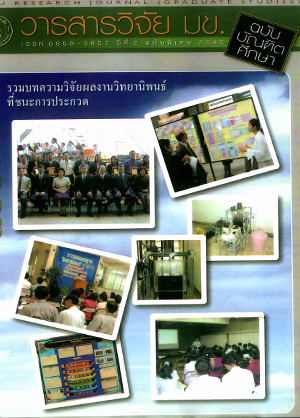Genetic Variations of the Liver fluke (Opisthorchis viverrini) in northeast Thailand and Laos PDR by Random Amplified Polymorphic DNA (ความผันแปรทางพันธุกรรมของพยาธิใบไม้ตับ (Opisthorchis viverrini) ใน ภาคตะวันออกเฉียงเหนือของประเทศไทยและประเทศลาว)
Keywords:
Opisthorchis viverrini, Genetic variations, Random amplified polymorphic DNAAbstract
Liver fluke (~iOpisthorchis viverrini;~i OV) is the leading parasitic helminth in Northeast Thailand and Laos Peoples Democratic Republic (PDR). The infection induces various hepatobiliary diseases including cholangiocarcinoma (cancer of bile duct) which are important public health problem in both countries. To date there is no evidence showing the occurrence of genetic heterogeneity of the parasite population. This thesis, therefore, aims to explore the genetic variation among population of the liver fluke from different endemic areas in Northeast Thailand and Laos PDR by using the random amplified polymorphic DNA technique. Liver fluke samples collected from 8 locations in the Northeast Thailand namely Khon Kaen, Kalasin, Chaiyaphum, Maha Sarakham, Nakhon Phanom and a location from Laos PDR were analyzed using single strand 10 base primers. Four out of 15 random primers which yielded reliable products were selected for the analyses. Based on the pattern of DNA fingerprintings, the sampled parasites can be divided into 3-5 groups according to the type of primer used. When the DNA banding pattern of OV were analysed for the similarity coefficient and the phylogenetic trees constructed, primer B5 could differentiate 9 isolates of OV into 4 distinct groups. The similarity coefficient of these groupings were 86%, 66%, 56%, and 48%, respectively. By using primer B17, OV isolates were separated into 4 distinct groups with the similarity coefficients of 82%, 63%, 54%, and 27%, respectively. Primer A2 differentiated OV isolated into 3 distinct groups with the similarity coefficients of 85%, 80%, and 39%, respectively. Primer A17 differentiated 9 isolates of OV into 5 distinct groups with the similarity coefficients of 83%, 81.5%, 63%, 52, and 52%, respectively. The Laotian isolate displayed the most consistent difference in banding pattern to those from northeast Thailand. Studies on the causes of the observed genetic variations suggested that species of fish intermediate host may contribute to this finding since OV isolated from different fish species had different banding pattern. In particular, the banding patterns of OV from ~iPuntioplites proctozysron~i were highly variable. Analysis of the worms recovered from human autopsy subjects revealed that the worms also had considerable degree of genetic variability both within and between individuals. Patterns of DNA banding of the autopsy worms were similar to those of the OV from environmental isolates in Thailand but differed from those from Laos PDR. The results of this study have demonstrated for the first time that there are genetic variations among the liver fluke population within Thailand and between Thailand and Laos PDR. This finding forms basis for further studies on the relationship between the observed genetic variations and phenotypic expression of the liver fluke as well as other attributes such as geographical distribution, variation in prevalence and intensity of infection, pathogenesis as well as their roles in development of cholangiocarcinoma.
พยาธิใบไม้ตับ (Opisthorchis viverrini) เป็นหนอนพยาธิที่ระบาด อย่างแพร่หลายในภาคตะวันออกเฉียงเหนือของประเทศไทยและประเทศลาวมาเป็นเวลา นาน การติดเชื้อพยาธิใบไม้ตับเป็นสาเหตุของโรคระบบทางเดินท่อน้ำดีโดย เฉพาะมะเร็งท่อน้ำดี ซึ่งเป็นปัญหาสาธารณสุขที่สำคัญของทั้งสองประเทศตั้งแต่ อดีตจนถึงปัจจุบัน ในขณะนี้ยังไม่มีข้อมูลในการจำแนกสับสปีซีส์ หรือ สายพันธุ์ของพยาธิที่แสดงถึงความหลากหลายทางพันธุกรรมของประชากรพยาธิใบไม้ตับ เนื่องจากรูปร่างลักษณะภายนอกของพยาธิไม่แตกต่างกัน การศึกษานี้จึง มีวัตถุประสงค์ที่จะวิเคราะห์หาความแตกต่างด้านพันธุกรรมของพยาธิใบไม้ตับ ในปลาจากแหล่งระบาดต่างๆ ในภาคตะวันออกเฉียงเหนือของไทยและของประเทศลาว โดยวิธีแรนดอมแอมพลิไฟด์โพลีมอร์ฟิคดีเอ็นเอ ผลการวิเคราะห์ตัวอย่างพยาธิใบไม้ตับจากแหล่งระบาด 8 แห่งในภาคตะวัน ออกเฉียงเหนือของไทยได้แก่ จังหวัดขอนแก่น กาฬสิทธุ์ ชัยภูมิ มหาสารคาม นครพนม และจากประเทศลาว 1 แห่ง โดยใช้ไพรเมอร์สายเดี่ยว ชนิด 10 เบสที่ คัดเลือกมา 4 สายจากจำนวนที่ทดสอบทั้งหมด 15 สาย มาสร้างลายพิมพ์ดีเอ็นเอ การวิเคราะห์เปรียบเทียบลายพิมพ์ดีเอ็นเอ สามารถจำแนกตัวอย่างพยาธิใบไม้ตับ ทั้งหมดออกได้ 3-5 กลุ่ม ขึ้นอยู่กับชนิดของไพรเมอร์ จากการนำลายพิมพ์ ดีเอ็นเอที่ได้จากการใช้ไพรเมอร์ B5 มาหาค่าสัมประสิทธิ์ความคล้ายคลึงและ นำไปสร้างความสัมพันธ์ทางวิวัฒนาการทำให้สามารถแบ่งพยาธิใบไม้ตับ ออกเป็น 4 กลุ่ม โดยมีค่าสัมประสิทธิ์ความคล้ายคลึงเท่ากับ 86% 66% 56% และ 48% ตามลำดับ เมื่อใช้ไพรเมอร์ B17 สามารถแบ่งพยาธิใบไม้ตับออกได้เป็น 4 กลุ่ม โดยมีค่าสัมประสิทธิ์ความคล้ายคลึงเท่ากับ 82% 63% 54% และ 27% ตามลำดับ เมื่อใช้ไพรเมอร์ A2 สามารถแบ่งพยาธิใบไม้ตับออกได้เป็น 3 กลุ่ม โดยมีค่าสัมประสิทธ์ความคล้ายคลึงเท่ากับ 85% 80% และ 39% ตามลำดับ เมื่อใช้ไพรเมอร์ A17 สามารถแบ่งพยาธิใบไม้ตับออกได้เป็น 5 กลุ่ม โดยมีค่าสัมประสิทธ์ความคล้ายคลึงเท่ากับ 83% 81.5% 63% 48% และ 48% ตามลำดับ และพบว่าพยาธิ จากประเทศลาวมีลายพิมพ์ดีเอ็นเอแตกต่างกัน จากพยาธิของประเทศไทยอย่างชัดเจนไม่ว่าจะใช้ไพรเมอร์ใดใน 4 ชนิดดังกล่าว และถูกจัดให้อยู่คนละกลุ่มกับพยาธิจากประเทศไทย การศึกษาเบื้องต้นถึงสาเหตุ ของความผันแปรทางพันธุกรรมดังกล่าวนี้มีความสัมพันธ์กับชนิดของปลาซึ่ง เป็นโฮสต์ตัวกลางของพยาธิ โดยเฉพาะพยาธิใบไม้ตับจากปลาขาวเก (Puntius proctozysron) มีลายพิมพ์ดีเอ็นเอที่แตกต่างจากปลาชนิดอื่น ๆ ในปลาวงศ์ ปลาตะเพียน จากการวิเคราะห์พยาธิใบไม้ตับจากผู้เสียชีวิตจากอุบัติเหตุพบว่าพยาธิ มีความผันแปรทางพันธุกรรมทั้งในบุคคลเดียวกันและระหว่างบุคคล ซึ่งลายพิมพ์ ดีเอ็นเอของพยาธิใบไม้ตับในแต่ละบุคคลที่พบนั้นมีความคล้ายคลึงกับพยาธิ ใบไม้ตับจากแหล่งระบาดต่างๆในประเทศไทย แต่แตกต่างจากประเทศลาว ผลการศึกษานี้ได้แสดงเป็นครั้งแรกว่าประชากรพยาธิใบไม้ตับในประเทศไทย และลาวมีองค์ประกอบทางพันธุกรรมที่แตกต่างกัน และเป็นพื้นฐานสำคัญใน การศึกษาหาความสัมพันธ์ระหว่างพยาธิใบไม้ตับกลุ่มต่างๆ กับปัจจัยอื่นที่ เกี่ยวข้อง เช่น คุณสมบัติทางชีววิทยาของพยาธิ แหล่งระบาดความแปรปรวน ของการติดเชื้อ การก่อโรค ความรุนแรงของโรครวมทั้งความสัมพันธ์กับอุบัติการ ของการเกิดมะเร็งต่อไป



